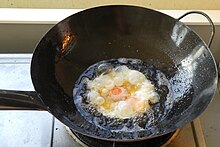
A wok is a deep round-bottomed cooking pan of Chinese origin. It is believed to be derived from the South Asian karahi. It is common in Greater China, and similar pans are found in parts of East, South and Southeast Asia, as well as being popular in other parts of the world.

Pakistani cuisine can be characterized as a blend of regional cooking styles and flavours from across South, Central and Western Asia. Pakistani cuisine is influenced by Persian, Indian, and Arab cuisine. The cuisine of Pakistan also maintains certain Mughal influences within its recipes and cooking techniques. Pakistan's ethnic and cultural diversity, diverse climates, geographical environments, and availability of different produce lead to diverse regional cuisines.
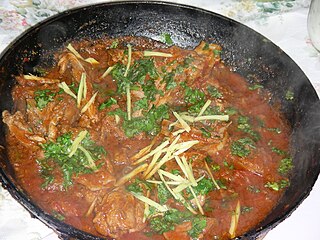
A balti or bāltī gosht is a type of curry served in a thin, pressed-steel wok called a "balti bowl". The name may have come from the metal dish in which the curry is cooked, rather than from any specific ingredient or cooking technique. Balti curries are cooked quickly using vegetable oil rather than ghee, over high heat in the manner of a stir-fry, and any meat is used off the bone. This combination differs sharply from a traditional one-pot Indian curry which is simmered slowly all day. Balti sauce is based on garlic and onions, with turmeric and garam masala, among other spices.

Pilaf, pilav or pilau is a rice dish, usually sautéed, or in some regions, a wheat dish, whose recipe usually involves cooking in stock or broth, adding spices, and other ingredients such as vegetables or meat, and employing some technique for achieving cooked grains that do not adhere to each other.
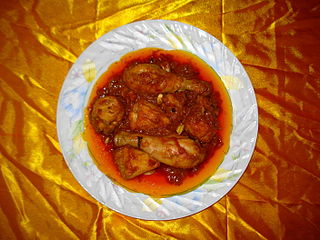
Korma or qorma ; Persian: قرما); is a dish with its origin in the Indian subcontinent, consisting of meat or vegetables braised with yogurt (dahi), water or stock, and spices to produce a thick sauce or gravy.

A tava(h) / tawa(h) (mainly on the Indian subcontinent), saj (in Arabic), sac (in Turkish), and other variations and combinations thereof, is a metal-made cooking utensil. The tawa is round and can be flat, but more commonly has a curved profile, and while the concave side can be used as a wok or frying pan, the convex side is used for cooking flatbreads and pancakes.
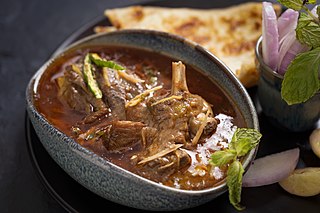
Nahari is a stew originating in Lucknow, the capital of 18th-century Awadh under the Mughal Empire in the Indian subcontinent. It consists of slow-cooked meat, mainly a shank cut of beef, lamb and mutton, or goat meat, as well as chicken and bone marrow. It is flavoured with long pepper, a relative of black pepper. In Pakistan and Bangladesh, nihari is often served and consumed with naan.
Gosht or ghosht refers to tender meat, cooked for a long time, and used as an ingredient in a number of Middle Eastern cuisine, Central Asian cuisine and cuisine of the Indian subcontinent. The word stems from the Persian word gosht گوشت, meaning "meat" or "flesh", especially that of goat.

Kofta is a family of meatball or meatloaf dishes found in South Asian, Central Asian, Balkan, Middle Eastern, North African, and South Caucasian cuisines. In the simplest form, koftas consist of balls of minced meat – usually beef, chicken, pork, lamb or mutton, or a mixture – mixed with spices and sometimes other ingredients. The earliest known recipes are found in early Arab cookbooks and call for ground lamb.

Mughlai cuisine consists of dishes developed or popularised in the early-modern Indo-Persian cultural centres of the Mughal Empire. It represents a combination of cuisine of the Indian subcontinent with the cooking styles and recipes of Central Asian and Islamic cuisine. Mughlai cuisine is strongly influenced by the Turkic cuisine of Central Asia, the region where the early Mughal emperors originally hailed from, and it has in turn strongly influenced the regional cuisines of Northern India, Pakistan and Bangladesh.

Dhansak is a popular Indian dish, originating among the Parsi community. It combines elements of Persian and Gujarati cuisine. Dhansak is made by cooking mutton or goat meat with a mixture of lentils and vegetables. This is served with caramelised white rice, whole spices, and caramelized onions.

Lahori cuisine refers to the food and cuisine of the city of Lahore in Punjab, Pakistan. It is a part of regional Punjabi cuisine. Lahore is a city with an extremely rich food culture. People from Lahore are famous all over the country for their love for food. The city offers a vast variety of options when it comes to gastronomy. In recent times, the style of food has achieved popularity in a number of different countries, because of its palatable and milder taste, mainly through the Pakistani diaspora.

Chicken karahi, or kadai chicken, is a chicken dish from South Asia.

Aloo gosht is a meat curry, and is a popular dish in North Indian, Pakistani, and Bangladeshi cuisine. It consists of potatoes (aloo) cooked with meat (gosht), usually lamb or mutton or beef, in a stew-like shorba gravy. It may be considered a curry, stew, or shorba depending on the way the dish is prepared, the types of spices used and what country or particular region it was made in. The dish can be served and eaten with plain rice or with bread such as roti, paratha, or naan.
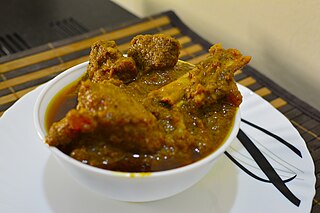
Mutton curry is a dish that is prepared from goat meat and vegetables. The dish is found in different variations across all states, countries and regions of the Indian subcontinent and the Caribbean.

A stew is a combination of solid food ingredients that have been cooked in liquid and served in the resultant gravy. Ingredients can include any combination of vegetables and may include meat, especially tougher meats suitable for slow-cooking, such as beef, pork, venison, rabbit, lamb, poultry, sausages, and seafood. While water can be used as the stew-cooking liquid, stock is also common. A small amount of red wine or other alcohol is sometimes added for flavour. Seasonings and flavourings may also be added. Stews are typically cooked at a relatively low temperature, allowing flavours to mingle.

